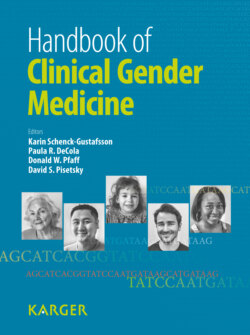Читать книгу Handbook of Clinical Gender Medicine - Группа авторов - Страница 122
Epidemiology
ОглавлениеIt is widely documented that women are twice as likely as men to meet criteria for lifetime major depressive disorder, a finding that has been confirmed across many countries, cultures, and ethnic groups [1]. Depression occurs at approximately the same rate in boys and girls; however, small sex differences emerge between the ages of 13 and 15. This gap further widens later in adolescence, and the depression rate in women remains elevated until midlife [2].
Although women are more prone to initially develop depression, there are no clear-cut sex differences in the duration or recurrence of the disorder [2]. Sex differences in rates of comorbid psychiatric disorders and prevalence of certain symptoms, however, have been identified. Women are two-to three-fold more likely than men to exhibit atypical depression. This condition is characterized by mood reactivity, appetite and weight increase, hypersomnia, and interpersonal sensitivity. Atypical depression is associated with higher rates of comorbid psychiatric illness and typically has an early onset and chronic course. Its greater prevalence in women may contribute to sex differences in presentation reported in some studies. Additionally, depression often occurs in tandem with other disorders that may complicate evaluation and treatment response in men and women. Common comorbidities that alter treatment response in depression include anxiety disorders, eating disorders, and substance abuse. While women with depression are more likely to endorse symptoms associated with general anxiety disorder and bulimia, depressed men are more likely to exhibit symptoms of alcohol and drug use and dependence. Furthermore, among those with chronic medical conditions such as diabetes and coronary heart disease, women are more likely than men to exhibit comorbid depressive symptoms.
